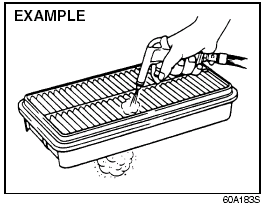Improving Fuel Economy
The following instructions will help you improve fuel economy.
Avoid excessive idling
If you are to wait for more than a minute while you are parked, stop the engine and start it again later. When warming up a cold engine, allow the engine to idle until the temperature gauge pointer comes up to the “C” position. In this position, the engine is sufficiently warm for starting off.
Avoid “jackrabbit” starts
Fast starts away from lights or stop signs will consume fuel unnecessarily and shorten engine life. Start off slowly.
Avoid unnecessary stops
Avoid unnecessary deceleration and stopping.
Try to maintain a slow, steady speed whenever possible. Slowing down and then accelerating again uses more fuel.
Keep a steady cruising speed
Keep as constant a speed as road and traffic conditions will permit.

Keep the air cleaner clean
A dirty air cleaner will cause the fuel injection system to supply too much fuel to the engine for the amount of air being supplied.
The result is waste of fuel due to incomplete fuel burning.
Keep weight to a minimum
The heavier the load, the more fuel the vehicle consumes. Take out any luggage or cargo when it is not necessary.
Keep tire pressure correct
Underinflation of the tires can waste fuel due to increased running resistance of the tires. Keep your tires inflated to the correct pressure shown on the label located below the driver’s side door latch striker.
See also:
Other Controls and Equipment
...
Roof Rails or Roof Rack Anchors (if equipped)
Roof rails
Roof rack anchors
You can use the roof rails or the roof rack
anchors to attach the optional roof rack
which is available at your SUZUKI dealer.
If you use a roof rack, observe the ...
Starting the Engine
Before Starting the Engine
1) Make sure the parking brake is set fully.
2) Manual Transmission – Shift into “N”
(Neutral) and depress the clutch pedal
all the way to the floor.
Hold it whil ...
